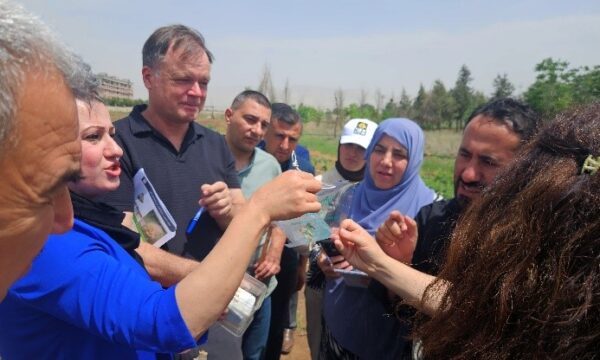
XAG is implementing UAV drone systems to tackle fall armyworm infestations across China (© Pexels)
Fall armyworm (FAW) has continued to spread across China since early January, with the pest being identified in over 600,000 hectares of farmland across 18 provinces. Now, the government and farmers are looking for solutions to tackling this invasive species.
Fall armyworm in an incredibly destructive pest species native to the tropics and sub-tropics of Central and Southern America, which has now invaded over 100 countries and destroyed millions of hectares of crops since 2016. The larval caterpillar feeds on over 80 varieties of crop, but is notably devastating among maize, causing severe damage to the leaves, stems and cobs of maize crops.
The adult moth can fly up to 100 km in a single night and lay up to a thousand eggs in its lifetime. Such strong migratory and reproductive abilities have played a key role in its success as an invasive species. Fall armyworm was first identified in the African continent in early 2016, causing an annual yield loss across high maize-producing countries such as Nigeria and South Africa at an estimated USD 4.6 billion in 2018. The pest rapidly spread throughout the region before reaching Asia in July 2018.
Chemical control is currently one of the most actively used methods for containing and reducing the spread of fall armyworm. However, within the management practice of chemical spraying, many farmers are resorting to traditional manual spraying which can often result in poor outcomes. Manual spraying has a number of issues when it comes to fall armyworm, as traditional spraying is time-consuming and therefore can’t keep up with the rapid infestation rates of the pest. The nature of fall armyworm itself makes it difficult to effectively use chemical spraying, as the larvae are commonly hidden within plant material such as maize cobs and thereby out of reach from sprayed chemical control.

Fall armyworm (Spodoptera frugiperda) is one of the world’s leading invasive species, threatening food security globally (© CABI)
XAG, one of the world’s leading Unmanned Aerial Vehicle (UAV) manufacturers, has developed a solution to these issues using precision UAV spraying technologies. A common practice used across Southern and Eastern Asia, UAV spraying is estimated to be actively used for pest management in 30% of South Korean agricultural land. In what has been termed ‘drone swarm operations’, drones are deployed to infested cropland where novel atomised sraying mechanisms built onto the drones apply chemical control to the crops over large areas to combat the fall armyworm infestation. The atomised sprayer applies uniform applications of the required chemical to both sides of the leaves and central parts of crops (where fall armyworm larvae are commonly found) in a more precise way that requires low volumes of the chemical. This results in an increased exposure of the fall armyworm to pesticides.
The benefits of using UAVs in agricultural practices include the ability to access difficult topographic regions which would normally be difficult to access and manually apply chemical treatments effectively, or for areas with high soil moisture levels preventing terrestrial access. A study published by Giles and Billing, 2015 found that with the use of suitable field pattern manipulation, spray application rates of 10-50 litres per hectare can be achieved, with the use of on-board stabilizer systems coupled with the autonomous nature of modern agri-UAVs greatly reducing the requirement and workload for operating staff and training. The potential benefits also include lowered risks to human health, specifically when applying chemical treatments, as the time taken directly handling chemicals and working within treated areas is greatly reduced.

UAV drones are a hopeful new tool to promote time-sensitive actions on pest and disease outbreaks threatening crop production (© Pexels)
Difficulties surrounding the use of UAVs in agriculture vary based on the region. For example, farms containing large areas of land can be difficult to capture in drone spraying applications, as the maximum chemical load of many commercial drones are relatively small (10-15 kg) due to mechanical weight restrictions. General chemical spraying UAVs carry 1 Ha worth of a given chemical, resulting in the need for numerous gaps in application activity to refill the equipment. Many drone sprayer systems, such as those used by XAG use fine sprayer technologies to provide more accurate chemical applications, however the use of smaller chemical droplets risk negative impacts from evaporation and aerodynamic variation.
In China, XAG has been working closely with the government, international and agrochemical companies and distributors to provide validated chemical control based on their precision spraying technology. In Guangxi Province, XAG and Bayer Crop Science instigated the first emergency control of fall armyworm earlier this year to help local farmers prevent the damage caused by the spreading insect pest on maize and sugarcane. The results from this event showed that drones loaded with low-toxicity synthetic insecticides successfully killed the pests, with XAG reporting mortality rates of up to 90%.
If you would like to read more on this subject, please see the links below:
1 Comment
Leave a Reply
Related News & Blogs
Biological control in action: Zambia’s field days on fighting fall armyworm
Experts from CABI recently held two field days and an expo in Zambia, showcasing innovative approaches to pest management to 584 farmers, agro-dealers and other stakeholders to help raise awareness of approaches to tackle the invasive fall armyworm (Sp…
11 June 2025





I am a PhD. student, working on the sustainable management of fall armyworm in Nigeria using intercropping and my preliminary data has shown that infestation can be reduced by using legumes such as soybean. Also, I discovered that Beuvaria bassiana and Aspergillus flavus, fungi are deadly natural enemies of the pest.